Researchers hope llama antibodies could help protect humans who have not been infected
Matthew Cantor in Oakland
Sun 17 May 2020
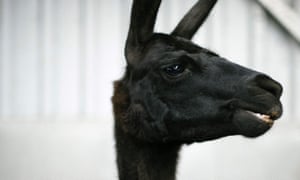
International researchers owe their findings to a llama named Winter, a four-year-old resident of Belgium. Photograph: VIB-UGent Center for Medical Bio/AFP via Getty Images
The solution to the coronavirus may have been staring us in the face this whole time, lazily chewing on a carrot. All we need, it seems, is llamas.
A study published last week in the journal Cell found that antibodies in llamas’ blood could offer a defense against the coronavirus. In addition to larger antibodies like ours, llamas have small ones that can sneak into spaces on viral proteins that are too tiny for human antibodies, helping them to fend off the threat. The hope is that the llama antibodies could help protect humans who have not been infected.
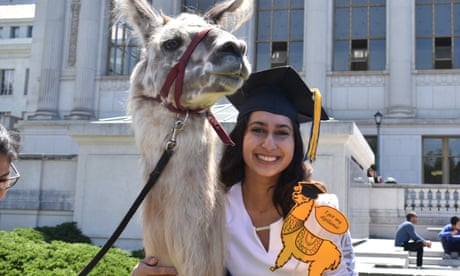
International researchers owe their findings to a llama named Winter, a four-year-old resident of Belgium. Her antibodies had already proven themselves able to fight Sars and Mers, leading researchers to speculate that they could work against the virus behind Covid-19 – and indeed, in cell cultures at least, they were effective against it. Researchers are now working towards clinical trials. “If it works, llama Winter deserves a statue,” Dr Xavier Saelens, a Ghent University virologist and study author, told the New York Times.
To any llama aficionado, this news should come as no surprise. The animals have developed a reputation for healing. Llama antibodies have been a fixture in the fight against disease for years, with researchers investigating their potency against HIV and other viruses.
And their soothing powers go beyond the microscopic. Llamas have become exam-season fixtures at a number of top US colleges. George Caldwell, who raises llamas in Sonora, California, brings his trusted associates to the University of California, Berkeley, UC Davis, Stanford, and other northern California universities and high schools, where their tranquility is contagious, helping students overcome end-of-term anxiety. “When you’re around a llama, you become very calm and at peace,” one Berkeley senior said at a campus event last year.
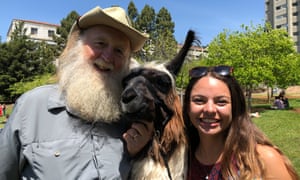
George Caldwell with Ana Claire Mancia, a Berkeley senior, last year, and a mutual friend. Photograph: Matthew Cantor/The Guardian
At that event, I joined the ranks of the converted, having had the good fortune to receive a “llama greeting”, which involves warm llama breath hitting one’s face. It was the most pleasant nostril-based salutation I have ever received – all my anxieties seemed to dissipate in the llama-generated air. (This was long before the pandemic, which has largely ruined the appeal of being breathed on.)
Humans and llamas are natural allies, said Caldwell, though too few realize it. “People see the llamas, they all light up,” he said. “Llamas just have that ability – it’s programmed right into us.” Their hair can be used to make clothing, their manure benefits crops, and as Winter’s antibodies reaffirm, “even their blood can help us”. And they are known as pack animals, a skill currently serving them well in Wales, where these hairy essential workers are delivering groceries.
“Everything about these guys – you’d think that they’d be the most valued creature in the world,” Caldwell said. His goal is to spread the word about their gifts: “Llamas are the real unicorns.”
Now they are doing their part inside and outside the laboratory. Caldwell has discussed collecting antibodies with his vet, but it is not an easy process, he says, especially for an older person: some llamas are less than eager to become blood donors, and they can be “ruffians” when the situation calls for it.
They are offering their services elsewhere, however. The pandemic has halted campus visits for now, so Caldwell has moved some operations online. This month he offered a live-streamed tour of his llamas’ residence, hosted by UC Davis.
The creatures’ enclosure was a picture of peace, where Quinoa, Joolz, McSlick and friends sat munching and gazing out at the world, blissfully unaware of the global pandemic, or perhaps simply confident that better times lie ahead.
With Winter on our side, they could be right.
'The magic of llamas': furry friends help stressed university students relax
Students at UC Berkeley have an unusual way to take the edge off before final exams. The Guardian was granted exclusive access to a petting session
Matthew Cantor in Berkeley @CantorMatthew
'The magic of llamas': furry friends help stressed university students relax
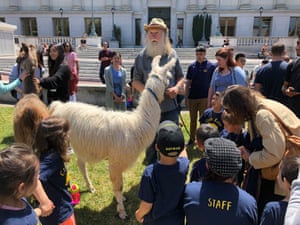
George Caldwell with kids and Munay the llama. Photograph: Matthew Cantor/The Guardian
Caldwell had been bringing the animals to Berkeley to destress the students for several years before Mancia launched Llamapalooza, but the event was somewhat under the radar.
Llamapalooza changed that. Now, the event typically gets 5,000 RSVPs on Facebook, Mancia says, with one to two thousand students actually showing up.
The llamas’ success has inspired many local universities to follow Berkeley’s lead. Quinoa and the gang have made inroads at UC San Francisco, UC Davis and Stanford. This week, they offered comfort at a high school where a student had recently passed away.
“These llamas allow you to love them … And once you get a big dose of love, that changes whatever mood you’re in,” Caldwell said. “That’s the magic of the llamas.”
'The magic of llamas': furry friends help stressed university students relaxStudents at UC Berkeley have an unusual way to take the edge off before final exams. The Guardian was granted exclusive access to a petting session
Students at UC Berkeley have an unusual way to take the edge off before final exams. The Guardian was granted exclusive access to a petting session
Matthew Cantor in Berkeley @CantorMatthew
THE GUARDIAN
Annam Quraishi with Quinoa the llama at Berkeley, 3 May 2019. She had been preparing for this moment for weeks, she said. Photograph: Hezekiah Burton
Final exams are approaching at one of America’s elite universities, and the atmosphere might be tense – if it weren’t for eight hairy campus visitors.
On Friday, students flocked to UC Berkeley’s Memorial Glade for Llamapalooza, a human-llama social occasion on a sunny campus lawn. The eight animals were scattered throughout the crowd, munching grass while the adoring masses petted, fed and photographed them under the supervision of trained student volunteers.
The semesterly event is intended to help Berkeley students relax before the tests. For many, it works.
Grace Park, a junior, had an exam that very day – but her interactions with the animals left her feeling “significantly less stressed”, she said. “It’s very wholesome,” added Mazel Mihardja, also a junior.

Why llamas are the new unicorns (just don’t mention the spitting)
Ana Claire Mancia, a business major who graduates this year, launched Llamapalooza a year and a half ago. The Guardian was granted exclusive access to her final event as a student, as she sought to avoid the heavy press presence of previous semesters.
“When you’re around a llama, you become very calm and at peace,” she said. Any reputation the animals have for spitting was undeserved, she noted: such behavior is reserved for inter-llama disputes. When it comes to humans, “you would have to really agitate it and be super in its face and irritate it for a llama to spit at you”.
Final exams are approaching at one of America’s elite universities, and the atmosphere might be tense – if it weren’t for eight hairy campus visitors.
On Friday, students flocked to UC Berkeley’s Memorial Glade for Llamapalooza, a human-llama social occasion on a sunny campus lawn. The eight animals were scattered throughout the crowd, munching grass while the adoring masses petted, fed and photographed them under the supervision of trained student volunteers.
The semesterly event is intended to help Berkeley students relax before the tests. For many, it works.
Grace Park, a junior, had an exam that very day – but her interactions with the animals left her feeling “significantly less stressed”, she said. “It’s very wholesome,” added Mazel Mihardja, also a junior.

Why llamas are the new unicorns (just don’t mention the spitting)
Ana Claire Mancia, a business major who graduates this year, launched Llamapalooza a year and a half ago. The Guardian was granted exclusive access to her final event as a student, as she sought to avoid the heavy press presence of previous semesters.
“When you’re around a llama, you become very calm and at peace,” she said. Any reputation the animals have for spitting was undeserved, she noted: such behavior is reserved for inter-llama disputes. When it comes to humans, “you would have to really agitate it and be super in its face and irritate it for a llama to spit at you”.
'The magic of llamas': furry friends help stressed university students relax
Ana Claire Mancia, a business major who graduates this year, launched Llamapalooza a year and a half ago. The Guardian was granted exclusive access to her final event as a student, as she sought to avoid the heavy press presence of previous semesters.
“When you’re around a llama, you become very calm and at peace,” she said. Any reputation the animals have for spitting was undeserved, she noted: such behavior is reserved for inter-llama disputes. When it comes to humans, “you would have to really agitate it and be super in its face and irritate it for a llama to spit at you”.
Indeed, despite being surrounded by throngs of overexcited humans, the llamas themselves remained remarkably calm. Their drooping eyelashes created an impression of utter contentment as they helped themselves to large quantities of campus vegetation. A student volunteer said Lorenzo the llama, known to friends as Zoe, was feeling a little overwhelmed, but it was difficult for this reporter to tell.

Many students took pre-exam solace in the llamas’ fur, lauded as “quite fuzzy” and “surprisingly soft”. “I want to pet them forever,” said Phoebe Kay, a junior from Australia.
But interactions weren’t limited to petting. Mancia taught the Guardian what is known as a “llama greeting”. The trick is to approach the animal nose-to-nose and “breathe the same air”, she said.
Having heard that llamas could be temperamental, the Guardian was initially nervous about engaging closely with the animals. But such fears were unfounded: while this reporter was debating how close to get, a llama named Munay performed the greeting uninvited, blowing hot llama air from his nostrils. It was as soothing as advertised.
Lorenzo (Zoe) the llama at Berkeley. Photograph: Matthew Cantor/The Guardian
That success inspired the Guardian to go further and feed the elder statesman of the bunch, a 14-year-old male called Quinoa for his speckled head. The process was daunting: the feeder provides the carrot directly from their own mouth. But Quinoa nonchalantly plucked it from the Guardian’s teeth and it disappeared in an instant.
This easy rapport is why George Caldwell, who raises the llamas and brings them to campus, believes they are so well-suited to such visits. Thanks to a long history living among humans in South America, “these guys developed social skills that are just amazing”, Caldwell says. “That’s the way they can put up with all these people coming around them and touching them and everything, because they realize their intentions are just social, family: good intentions.”
Caldwell’s dream, he said, would be to facilitate more human-llama hangouts. It would be mutually beneficial: not only would it relieve stress, it would ensure that humans don’t abandon the animals. “The llamas, if they’re gonna be around in the 21st, 22nd century, they need to get jobs.”
“When you’re around a llama, you become very calm and at peace,” she said. Any reputation the animals have for spitting was undeserved, she noted: such behavior is reserved for inter-llama disputes. When it comes to humans, “you would have to really agitate it and be super in its face and irritate it for a llama to spit at you”.
Indeed, despite being surrounded by throngs of overexcited humans, the llamas themselves remained remarkably calm. Their drooping eyelashes created an impression of utter contentment as they helped themselves to large quantities of campus vegetation. A student volunteer said Lorenzo the llama, known to friends as Zoe, was feeling a little overwhelmed, but it was difficult for this reporter to tell.

Many students took pre-exam solace in the llamas’ fur, lauded as “quite fuzzy” and “surprisingly soft”. “I want to pet them forever,” said Phoebe Kay, a junior from Australia.
But interactions weren’t limited to petting. Mancia taught the Guardian what is known as a “llama greeting”. The trick is to approach the animal nose-to-nose and “breathe the same air”, she said.
Having heard that llamas could be temperamental, the Guardian was initially nervous about engaging closely with the animals. But such fears were unfounded: while this reporter was debating how close to get, a llama named Munay performed the greeting uninvited, blowing hot llama air from his nostrils. It was as soothing as advertised.

Lorenzo (Zoe) the llama at Berkeley. Photograph: Matthew Cantor/The Guardian
That success inspired the Guardian to go further and feed the elder statesman of the bunch, a 14-year-old male called Quinoa for his speckled head. The process was daunting: the feeder provides the carrot directly from their own mouth. But Quinoa nonchalantly plucked it from the Guardian’s teeth and it disappeared in an instant.
This easy rapport is why George Caldwell, who raises the llamas and brings them to campus, believes they are so well-suited to such visits. Thanks to a long history living among humans in South America, “these guys developed social skills that are just amazing”, Caldwell says. “That’s the way they can put up with all these people coming around them and touching them and everything, because they realize their intentions are just social, family: good intentions.”
Caldwell’s dream, he said, would be to facilitate more human-llama hangouts. It would be mutually beneficial: not only would it relieve stress, it would ensure that humans don’t abandon the animals. “The llamas, if they’re gonna be around in the 21st, 22nd century, they need to get jobs.”

George Caldwell with kids and Munay the llama. Photograph: Matthew Cantor/The Guardian
Caldwell had been bringing the animals to Berkeley to destress the students for several years before Mancia launched Llamapalooza, but the event was somewhat under the radar.
Llamapalooza changed that. Now, the event typically gets 5,000 RSVPs on Facebook, Mancia says, with one to two thousand students actually showing up.
The llamas’ success has inspired many local universities to follow Berkeley’s lead. Quinoa and the gang have made inroads at UC San Francisco, UC Davis and Stanford. This week, they offered comfort at a high school where a student had recently passed away.
“These llamas allow you to love them … And once you get a big dose of love, that changes whatever mood you’re in,” Caldwell said. “That’s the magic of the llamas.”
'The magic of llamas': furry friends help stressed university students relaxStudents at UC Berkeley have an unusual way to take the edge off before final exams. The Guardian was granted exclusive access to a petting session
Matthew Cantor in Berkeley @CantorMatthew
THE GUARDIAN
Annam Quraishi with Quinoa the llama at Berkeley, 3 May 2019. She had been preparing for this moment for weeks, she said. Photograph: Hezekiah Burton
Final exams are approaching at one of America’s elite universities, and the atmosphere might be tense – if it weren’t for eight hairy campus visitors.
On Friday, students flocked to UC Berkeley’s Memorial Glade for Llamapalooza, a human-llama social occasion on a sunny campus lawn. The eight animals were scattered throughout the crowd, munching grass while the adoring masses petted, fed and photographed them under the supervision of trained student volunteers.
The semesterly event is intended to help Berkeley students relax before the tests. For many, it works.
Grace Park, a junior, had an exam that very day – but her interactions with the animals left her feeling “significantly less stressed”, she said. “It’s very wholesome,” added Mazel Mihardja, also a junior.

Why llamas are the new unicorns (just don’t mention the spitting)
Ana Claire Mancia, a business major who graduates this year, launched Llamapalooza a year and a half ago. The Guardian was granted exclusive access to her final event as a student, as she sought to avoid the heavy press presence of previous semesters.
“When you’re around a llama, you become very calm and at peace,” she said. Any reputation the animals have for spitting was undeserved, she noted: such behavior is reserved for inter-llama disputes. When it comes to humans, “you would have to really agitate it and be super in its face and irritate it for a llama to spit at you”.
Final exams are approaching at one of America’s elite universities, and the atmosphere might be tense – if it weren’t for eight hairy campus visitors.
On Friday, students flocked to UC Berkeley’s Memorial Glade for Llamapalooza, a human-llama social occasion on a sunny campus lawn. The eight animals were scattered throughout the crowd, munching grass while the adoring masses petted, fed and photographed them under the supervision of trained student volunteers.
The semesterly event is intended to help Berkeley students relax before the tests. For many, it works.
Grace Park, a junior, had an exam that very day – but her interactions with the animals left her feeling “significantly less stressed”, she said. “It’s very wholesome,” added Mazel Mihardja, also a junior.

Why llamas are the new unicorns (just don’t mention the spitting)
Ana Claire Mancia, a business major who graduates this year, launched Llamapalooza a year and a half ago. The Guardian was granted exclusive access to her final event as a student, as she sought to avoid the heavy press presence of previous semesters.
“When you’re around a llama, you become very calm and at peace,” she said. Any reputation the animals have for spitting was undeserved, she noted: such behavior is reserved for inter-llama disputes. When it comes to humans, “you would have to really agitate it and be super in its face and irritate it for a llama to spit at you”.
'The magic of llamas': furry friends help stressed university students relax
Ana Claire Mancia, a business major who graduates this year, launched Llamapalooza a year and a half ago. The Guardian was granted exclusive access to her final event as a student, as she sought to avoid the heavy press presence of previous semesters.
“When you’re around a llama, you become very calm and at peace,” she said. Any reputation the animals have for spitting was undeserved, she noted: such behavior is reserved for inter-llama disputes. When it comes to humans, “you would have to really agitate it and be super in its face and irritate it for a llama to spit at you”.
Indeed, despite being surrounded by throngs of overexcited humans, the llamas themselves remained remarkably calm. Their drooping eyelashes created an impression of utter contentment as they helped themselves to large quantities of campus vegetation. A student volunteer said Lorenzo the llama, known to friends as Zoe, was feeling a little overwhelmed, but it was difficult for this reporter to tell.
Many students took pre-exam solace in the llamas’ fur, lauded as “quite fuzzy” and “surprisingly soft”. “I want to pet them forever,” said Phoebe Kay, a junior from Australia.
But interactions weren’t limited to petting. Mancia taught the Guardian what is known as a “llama greeting”. The trick is to approach the animal nose-to-nose and “breathe the same air”, she said.
Having heard that llamas could be temperamental, the Guardian was initially nervous about engaging closely with the animals. But such fears were unfounded: while this reporter was debating how close to get, a llama named Munay performed the greeting uninvited, blowing hot llama air from his nostrils. It was as soothing as advertised.
Lorenzo (Zoe) the llama at Berkeley. Photograph: Matthew Cantor/The Guardian
That success inspired the Guardian to go further and feed the elder statesman of the bunch, a 14-year-old male called Quinoa for his speckled head. The process was daunting: the feeder provides the carrot directly from their own mouth. But Quinoa nonchalantly plucked it from the Guardian’s teeth and it disappeared in an instant.
This easy rapport is why George Caldwell, who raises the llamas and brings them to campus, believes they are so well-suited to such visits. Thanks to a long history living among humans in South America, “these guys developed social skills that are just amazing”, Caldwell says. “That’s the way they can put up with all these people coming around them and touching them and everything, because they realize their intentions are just social, family: good intentions.”
Caldwell’s dream, he said, would be to facilitate more human-llama hangouts. It would be mutually beneficial: not only would it relieve stress, it would ensure that humans don’t abandon the animals. “The llamas, if they’re gonna be around in the 21st, 22nd century, they need to get jobs.”
“When you’re around a llama, you become very calm and at peace,” she said. Any reputation the animals have for spitting was undeserved, she noted: such behavior is reserved for inter-llama disputes. When it comes to humans, “you would have to really agitate it and be super in its face and irritate it for a llama to spit at you”.
Indeed, despite being surrounded by throngs of overexcited humans, the llamas themselves remained remarkably calm. Their drooping eyelashes created an impression of utter contentment as they helped themselves to large quantities of campus vegetation. A student volunteer said Lorenzo the llama, known to friends as Zoe, was feeling a little overwhelmed, but it was difficult for this reporter to tell.

Many students took pre-exam solace in the llamas’ fur, lauded as “quite fuzzy” and “surprisingly soft”. “I want to pet them forever,” said Phoebe Kay, a junior from Australia.
But interactions weren’t limited to petting. Mancia taught the Guardian what is known as a “llama greeting”. The trick is to approach the animal nose-to-nose and “breathe the same air”, she said.
Having heard that llamas could be temperamental, the Guardian was initially nervous about engaging closely with the animals. But such fears were unfounded: while this reporter was debating how close to get, a llama named Munay performed the greeting uninvited, blowing hot llama air from his nostrils. It was as soothing as advertised.

Lorenzo (Zoe) the llama at Berkeley. Photograph: Matthew Cantor/The Guardian
That success inspired the Guardian to go further and feed the elder statesman of the bunch, a 14-year-old male called Quinoa for his speckled head. The process was daunting: the feeder provides the carrot directly from their own mouth. But Quinoa nonchalantly plucked it from the Guardian’s teeth and it disappeared in an instant.
This easy rapport is why George Caldwell, who raises the llamas and brings them to campus, believes they are so well-suited to such visits. Thanks to a long history living among humans in South America, “these guys developed social skills that are just amazing”, Caldwell says. “That’s the way they can put up with all these people coming around them and touching them and everything, because they realize their intentions are just social, family: good intentions.”
Caldwell’s dream, he said, would be to facilitate more human-llama hangouts. It would be mutually beneficial: not only would it relieve stress, it would ensure that humans don’t abandon the animals. “The llamas, if they’re gonna be around in the 21st, 22nd century, they need to get jobs.”

George Caldwell with kids and Munay the llama. Photograph: Matthew Cantor/The Guardian
Caldwell had been bringing the animals to Berkeley to destress the students for several years before Mancia launched Llamapalooza, but the event was somewhat under the radar.
Llamapalooza changed that. Now, the event typically gets 5,000 RSVPs on Facebook, Mancia says, with one to two thousand students actually showing up.
The llamas’ success has inspired many local universities to follow Berkeley’s lead. Quinoa and the gang have made inroads at UC San Francisco, UC Davis and Stanford. This week, they offered comfort at a high school where a student had recently passed away.
“These llamas allow you to love them … And once you get a big dose of love, that changes whatever mood you’re in,” Caldwell said. “That’s the magic of the llamas.
Why llamas are the new unicorns (just don’t mention the spitting)
From jumpers and cushions to shower curtains and weddings, the South American camelid is this season’s must-have animal adornment
Sun 5 Nov 2017 Last modified on Mon 2 Jul 2018

A llama wedding in Oregon (the one on the left is an alpaca); and some llama-themed products. Photograph: Guardian Design Team
November can be a chilly, soul-sapping time. Not only is it dark at 5pm, but, most importantly, you have no idea what the next whimsical animal trend is. What on earth are you going to festoon your cushions with?
Fret no more – it’s llamas. Yes, it’s (finally) time to say goodbye to ubiquitous unicorns – one-horned, prancing, glittery, rainbow-covered idiots – and wave hello to your new friends. The South American domesticated camelids are ideal for the fashion crowd and social media obsessives alike. Not as relentlessly pink as flamingos, or as fishy as mermaids, they’re cuter than pugs, thanks to their shaggy coats, funny ears and expressive “smiles”. Even better, their exotic origins mean they pair perfectly with on-trend cacti, mountain ranges and bright hues.
In short, they are perfectly placed to be plastered across clothing, soft furnishings, homeware and absolutely everything, until your eyes bleed and llamas dance in your dreams. Llama shower curtain anyone? Go on. Llama doormat? It’s a must-have.
Even the word “llama” is on point – rhyming with the slogan-friendly drama, pyjama, and Obama. Alternatively, if you’re George at Asda, you could simply festoon jumpers with “Fa La La La Llama”, which may sound like word salad, but is, according to the supermarket chain, “a great way to upgrade traditional Christmas knitwear”.
Llamas may be about to hit the big time, but they have been bubbling under for a while. Fans of BBC Radio 4 soap The Archers will know that Ambridge culture vulture Lynda Snell has two llamas, Constanza and Salieri. Instagram account Llama With No Drama (@llamawithnodrama) has 100,000 followers (spoiler alert – not a real llama), and llamas are a wedding trend (although at this point, what isn’t?). Llama therapy is also a thing, and honestly, it sounds like the best therapy ever. If you live in Portland, Oregon or Vancouver, you could combine the two and hire a pair of therapy llamas dressed as a bride and groom for your wedding. That’s if you don’t mind being pushed to the floor and trampled as your guests rush to marvel at a llama in a veil. So go on, get stuck in. Buy a llama pencil case. Just don’t mention the spitting.
November can be a chilly, soul-sapping time. Not only is it dark at 5pm, but, most importantly, you have no idea what the next whimsical animal trend is. What on earth are you going to festoon your cushions with?
Fret no more – it’s llamas. Yes, it’s (finally) time to say goodbye to ubiquitous unicorns – one-horned, prancing, glittery, rainbow-covered idiots – and wave hello to your new friends. The South American domesticated camelids are ideal for the fashion crowd and social media obsessives alike. Not as relentlessly pink as flamingos, or as fishy as mermaids, they’re cuter than pugs, thanks to their shaggy coats, funny ears and expressive “smiles”. Even better, their exotic origins mean they pair perfectly with on-trend cacti, mountain ranges and bright hues.
In short, they are perfectly placed to be plastered across clothing, soft furnishings, homeware and absolutely everything, until your eyes bleed and llamas dance in your dreams. Llama shower curtain anyone? Go on. Llama doormat? It’s a must-have.
Even the word “llama” is on point – rhyming with the slogan-friendly drama, pyjama, and Obama. Alternatively, if you’re George at Asda, you could simply festoon jumpers with “Fa La La La Llama”, which may sound like word salad, but is, according to the supermarket chain, “a great way to upgrade traditional Christmas knitwear”.
Llamas may be about to hit the big time, but they have been bubbling under for a while. Fans of BBC Radio 4 soap The Archers will know that Ambridge culture vulture Lynda Snell has two llamas, Constanza and Salieri. Instagram account Llama With No Drama (@llamawithnodrama) has 100,000 followers (spoiler alert – not a real llama), and llamas are a wedding trend (although at this point, what isn’t?). Llama therapy is also a thing, and honestly, it sounds like the best therapy ever. If you live in Portland, Oregon or Vancouver, you could combine the two and hire a pair of therapy llamas dressed as a bride and groom for your wedding. That’s if you don’t mind being pushed to the floor and trampled as your guests rush to marvel at a llama in a veil. So go on, get stuck in. Buy a llama pencil case. Just don’t mention the spitting.
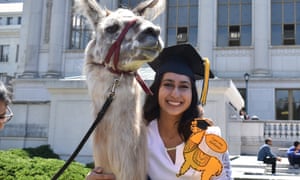
No comments:
Post a Comment